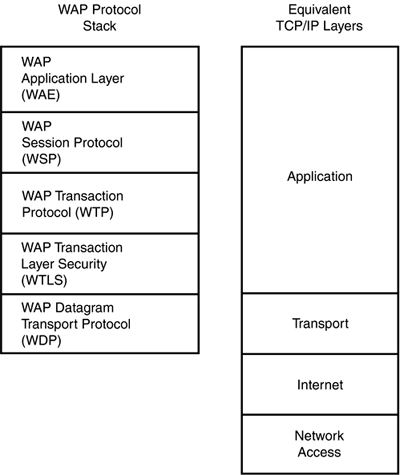Wireless Application Protocol (WAP)
| The Wireless Application Protocol (WAP) is a protocol stack designed specifically for wireless devices. Whereas 802.11 networks are similar in character to other forms of Ethernet, WAP is significantly different from ordinary TCP/IP. WAP is actually a specification for the upper application-related protocol layers. WAP was designed for delivering information to and from mobile handheld devices. The protocols of the WAP stack are tailored to the needs and influences of the wireless world. The WAP specification includes a markup language called Wireless Markup Language (WML) that is based on XML but specifically designed to provide the features necessary for constructing Web content for the small screens of handheld devices. WAP provides its own protocol layers that are roughly modeled on the upper layers of the OSI stack. The designers, however, did not mind diverging from strict OSI conformance to address the particular needs of the wireless environment. The WAP protocol layers, and the protocols associated with those layers, are shown in Figure 23.6. Like the other protocols described in this book, the WAP protocols describe a specification that is then implemented by vendors, who create the actual software. The WAP protocols include the following:
The WAP protocols represent the upper layers of the protocol stack. Note that WDP is similar to the UDP protocol, which resides on the Transport layer of TCP/IP's stack. The WAP stack therefore resides mostly at the TCP/IP Application layer. However, the real relationship of WAP with TCP/IP is a bit more complex. Because wireless networks are inherently slower and less reliable than cable-based networks, the WAP protocols are designed to deliver maximum performance. Some WAP protocols are in a binary format that must be translated to the text-based format of the TCP/IP protocols for the WAP device to receive Internet-related data transmissions. A device called a WAP gateway translates the WAP protocol information to an Internet-compatible format (see Figure 22.7). Figure 22.7. A WAP gateway translates the WAP protocol information to an Internet-compatible format.
The WAP suite includes other related protocols and languages not depicted in Figure 22.6, such as WMLScript (a scripting language) and WBMP (a bitmap format). Figure 22.6. The WAP protocol stack.
More recent WAP standards have proposed greater compatibility with TCP/IP and also greater compatibility with XML and HTML through XHTML, which will replace WML as the WAP markup language. |
EAN: 2147483647
Pages: 259
- Using SQL Data Manipulation Language (DML) to Insert and Manipulate Data Within SQL Tables
- Using Data Control Language (DCL) to Setup Database Security
- Working with SQL JOIN Statements and Other Multiple-table Queries
- Writing External Applications to Query and Manipulate Database Data
- Working with Ms-sql Server Information Schema View

